This week’s contributing blogger, Eugenie Milroy, is a Professional Associate member of the American Institute for Conservation (AIC) with over 20 years of museum and conservation experience. She is a principal at A.M. Art Conservation, LLC. The company helps institutions and individuals preserve their art and cultural property for future generations through conservation treatment, preservation consulting, collections management services, education and training.
Last Spring, AM Art Conservation examined eleven artworks in preparation for Lower Manhattan Cultural Council (LMCC)’s exhibition Michael Richards: Winged (on view at the Arts Center at Governors Island now through September 25). Most of the works on view, all by Richards, had not been exhibited in over 15 years. Some had been packed in temporary materials such as cardboard boxes, newspaper, and bubble wrap during the artist’s lifetime and were in storage at the time of his death on September 11, 2001. Since then, the collection had to be moved from a self-storage unit to a garage due to a fire in an adjacent storage space.
These artworks were stored in conditions that were not optimal for long-term preservation and a number of them exhibited damage and deterioration incurred during storage and transport. While this was certainly an exceptional circumstance, the fact that temporary storage begets long-term storage is not at all uncommon. This is why conservators stress the importance of using archival packing materials and storage furniture and choosing a storage area with stable environment as possible.
Michael Richards used a wide range of materials with varying sensitivity to environmental conditions (such as changes in temperature and relative humidity). Several works required treatment prior to exhibition while others were simply examined and documented. These treatments were an opportunity to clean and stabilize the works and, as appropriate, restore missing portions.
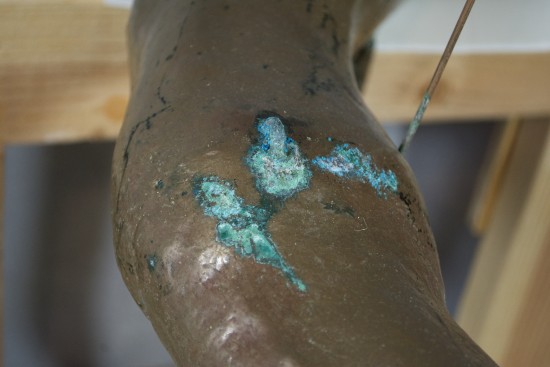
Detail of Winged before treatment. Copper corrosion products are seen on the “bonded bronze” surface and surrounding the iron alloy half ring mounting element
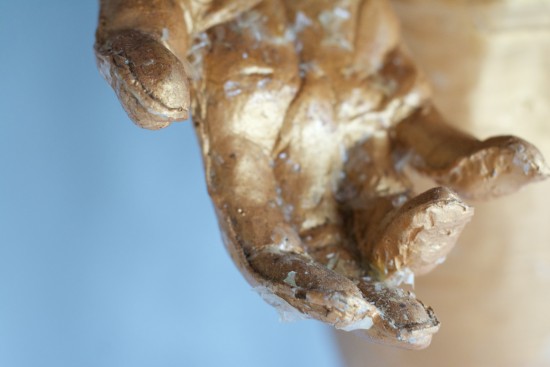
Tar Baby vs St. Sebastian before treatment, detail showing degraded bubble wrap and waxy coatings on right hand
Michael Richards adapted and experimented with media to create the visual and symbolic effects he desired. In addition to traditional materials such as plaster, paint, and wax, he employed a wide range of unconventional materials and unique applications in his artwork. These include human hair, synthetic hair, latex rubber, feathers, tar, barbed wire, and mechanical moving parts/motors. His choice of materials was deliberate and often had a direct correlation with significant themes in his work. He did a considerable amount of casting in fiberglass resin as well as cold cast metal or “bonded bronze.” This method gave the appearance of bronze without the cost associated with a foundry and the metal alloy itself. It also gave him direct control over the finished product.
One of his most widely known works, Tar Baby vs St. Sebastian, required the most extensive conservation treatment. This life-sized fiberglass figure was cast from his full body self-portrait. He built toy model airplanes of the same World War II fighter planes piloted by the Tuskegee Airmen, made molds from them, and then cast the airplanes in fiberglass and resin. Eighteen individual airplanes were attached to the body, the joins were filled and the whole sculpture was painted with metallic paint.
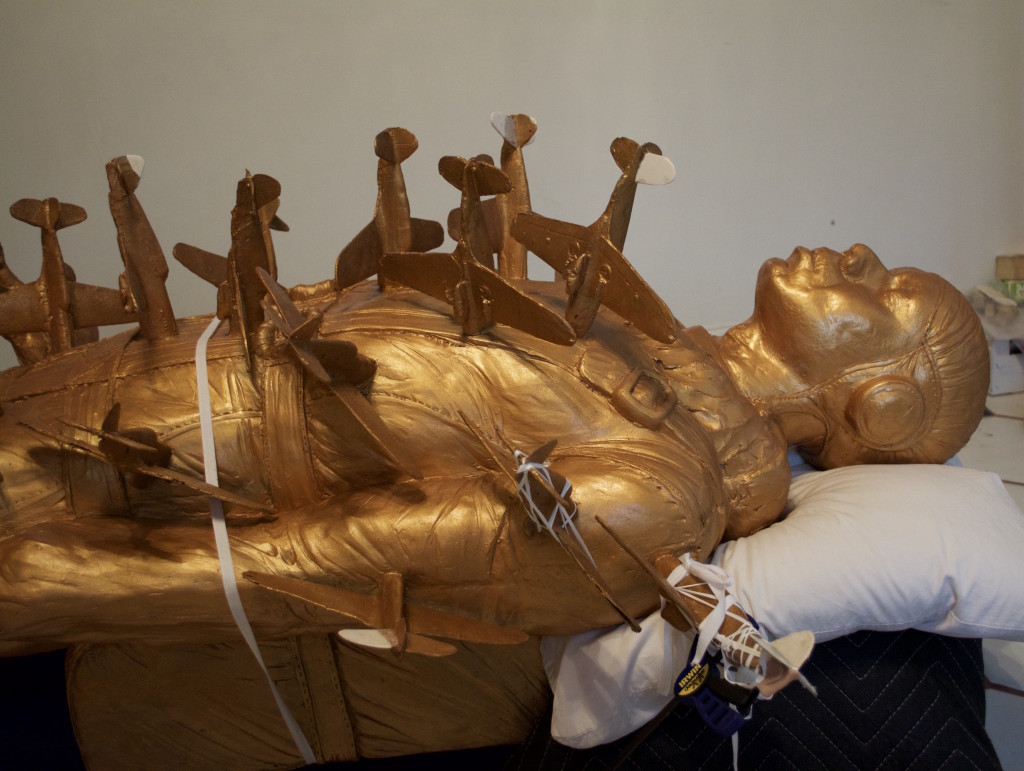
Tar Baby vs St. Sebastian during treatment, detail of upper body
Condition issues with the sculpture included broken and detached airplane parts and deposits on the surface. The storage unit fire had left soot deposits on the sculpture and caused the bubble wrap to fuse with waxy coatings on the surface leaving a pattern of round bubble wrap impressions. In other areas, the bubble wrap had broken down and plastic circles were stuck to the surface of the sculpture. Seventeen of the eighteen airplanes had some portion either detached or missing. The vertical and horizontal tail stabilizers were cast very thin – 2mm in some places so they were fragile and vulnerable to loss. Some missing pieces were recovered from the storage area. We were able to purchase and build the same model airplanes that Michael Richards had used in his work. Replacement pieces, including wings and tail parts, were created and carved from lightweight epoxy putty.
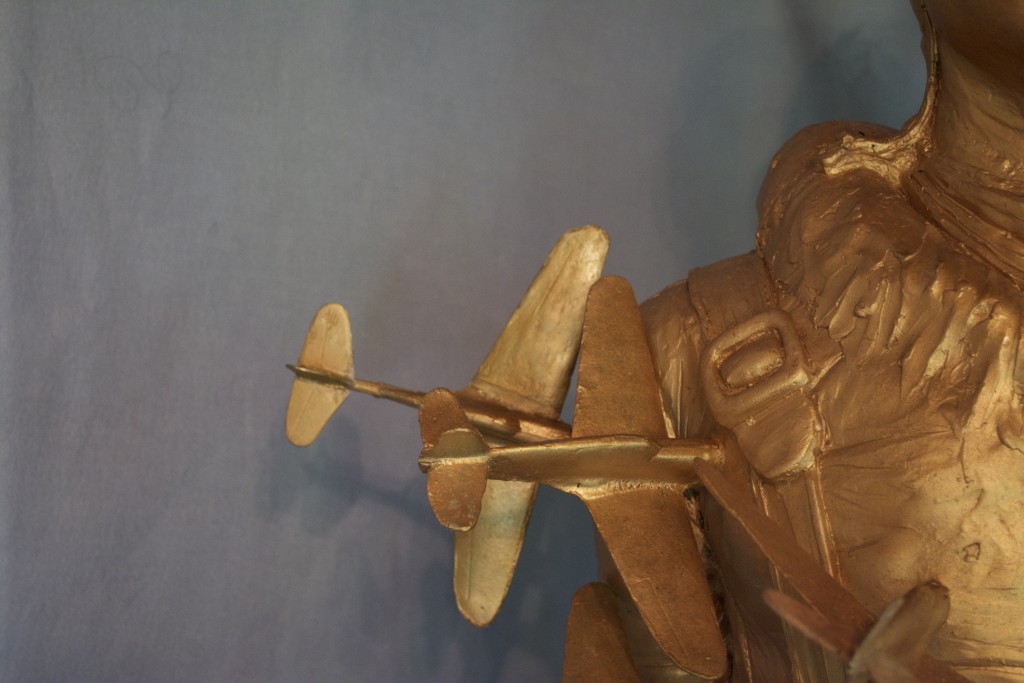
Tar Baby vs St. Sebastian after treatment, detail right forearm
The replacement elements were attached to the sculpture with an easily reversible acrylic resin. In cases where the join was very thin, a facing was applied to the surface using a heat set adhesive. Facings were placed on the least visible surface, usually the upright horizontal surfaces, and were toned to match surrounding areas. The integral iron stand and detachable base were extremely rusty with extensive areas of flaking paint. These were stripped, sanded, and repainted to match the original battleship gray color.
The exhibition’s titular artwork, Winged, exhibited some interesting condition issues and piqued our interest in further study of Richards’s process. The casting medium is bonded bronze or metallic powder mixed with resin (in this case it appears to be a polyester resin). The five pendant feathers are cast individually and attached to pointed steel rods. These pierce the main horizontal sculpture and are adhered to the underside of the piece. The construction of this piece meant that it had to be treated while on a custom stand that would allow access to all angles and both the upper and underside.
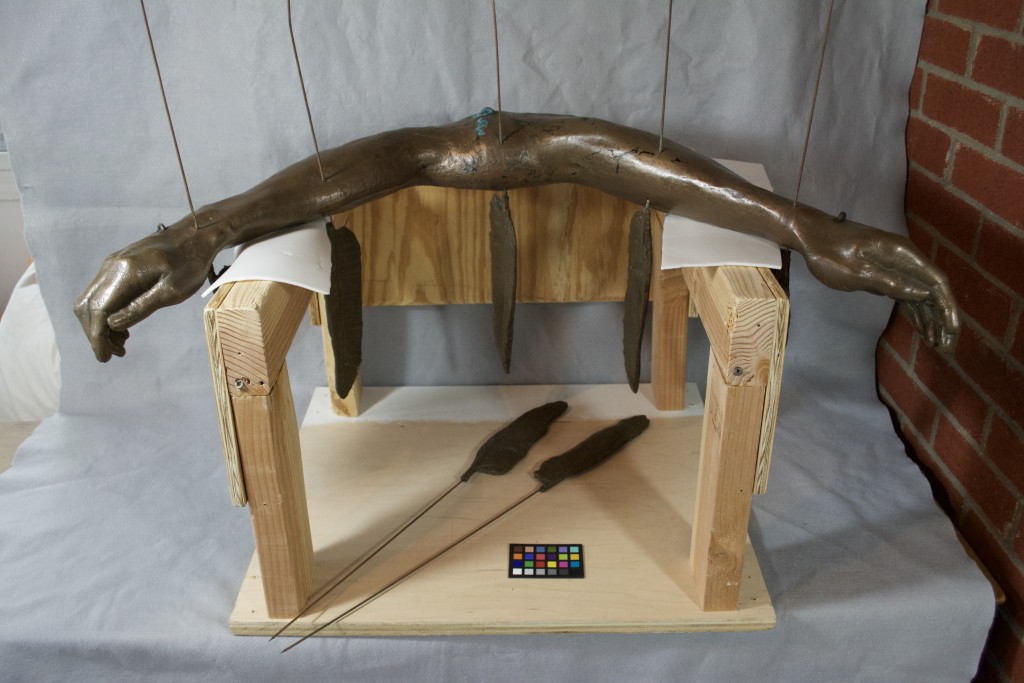
Winged, placed on a temporary support during treatment
Normally bonded bronze is relatively lightweight especially compared with bronze. This sculpture is hollow inside and only has a thin layer of metal at the surface. However, Winged is a heavy piece due to an internal steel armature that Richards incorporated into the sculpture. Three half ring attachments extend from the armature, allowing the piece to be mounted as if floating when hung from clear monofilament (fishing wire).
Given the prior storage conditions (high relative humidity), we would not have been surprised to see corrosion on a metal object of this type. In a bonded bronze the metal powder is mixed with and suspended in the resin, and the metal is not typically exposed to air. However, in this piece we saw numerous areas of copper corrosion that would be more typical of cast bronze. These may be due to irregularities in the powder and resin layer, both in thickness and in the ratio of resin to metal powder. Breakdown of the resin could also be a factor. There also seems to be a correlation with joins between separate cast pieces as well as where the armature protrudes from the surface.
Five fighter helmets on individual metal stands of varying height comprise The Great Black Airmen. The WWII era helmets with long ear flaps are covered on both the interior and exterior with synthetic hair that varies in texture from straight to kinky. The substrate of the helmets is plaster, coated in wax and painted. The hair was adhered to the surface and wrapped around and under the flaps. These pieces posed a problem known as “inherent vice,” as the hair is extremely fragile and vulnerable to loss from even gentle handling. The plaster-wax-paint system is susceptible to cracking and deformation/displacement. Four of the five helmets exhibited cracking in the plaster flaps and flaking and loss of the wax and paint layers. Given the wide range of materials and their various properties, choosing an adhesive to stabilize these was a challenge. These remained vulnerable even after treatment. Foam and fabric Interior mounts were created to reduce handling of the helmets and better support them atop their individual metal stands.
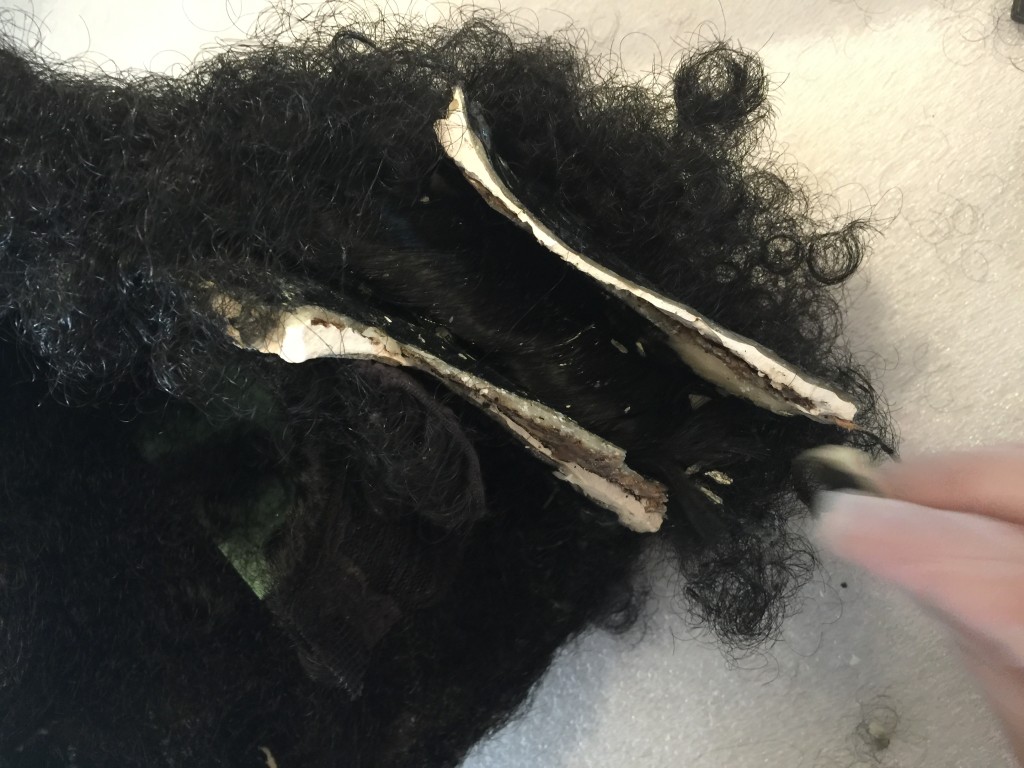
Helmet from The Great Black Airmen, shown during treatment
Although the treatment timeline did not allow for in-depth technical research of Michael Richards’s art, the conservation work revealed that the artist’s creative process is ripe for further investigation.
